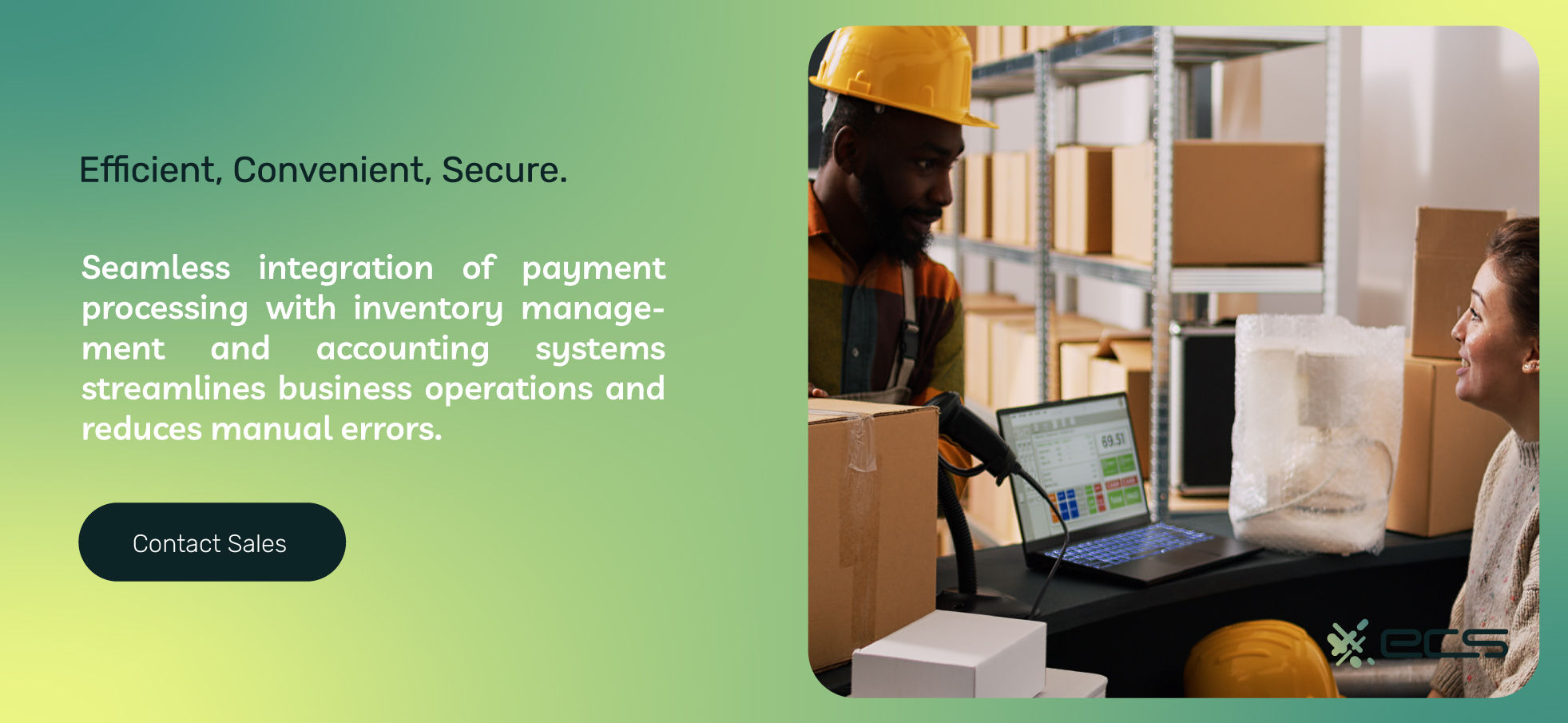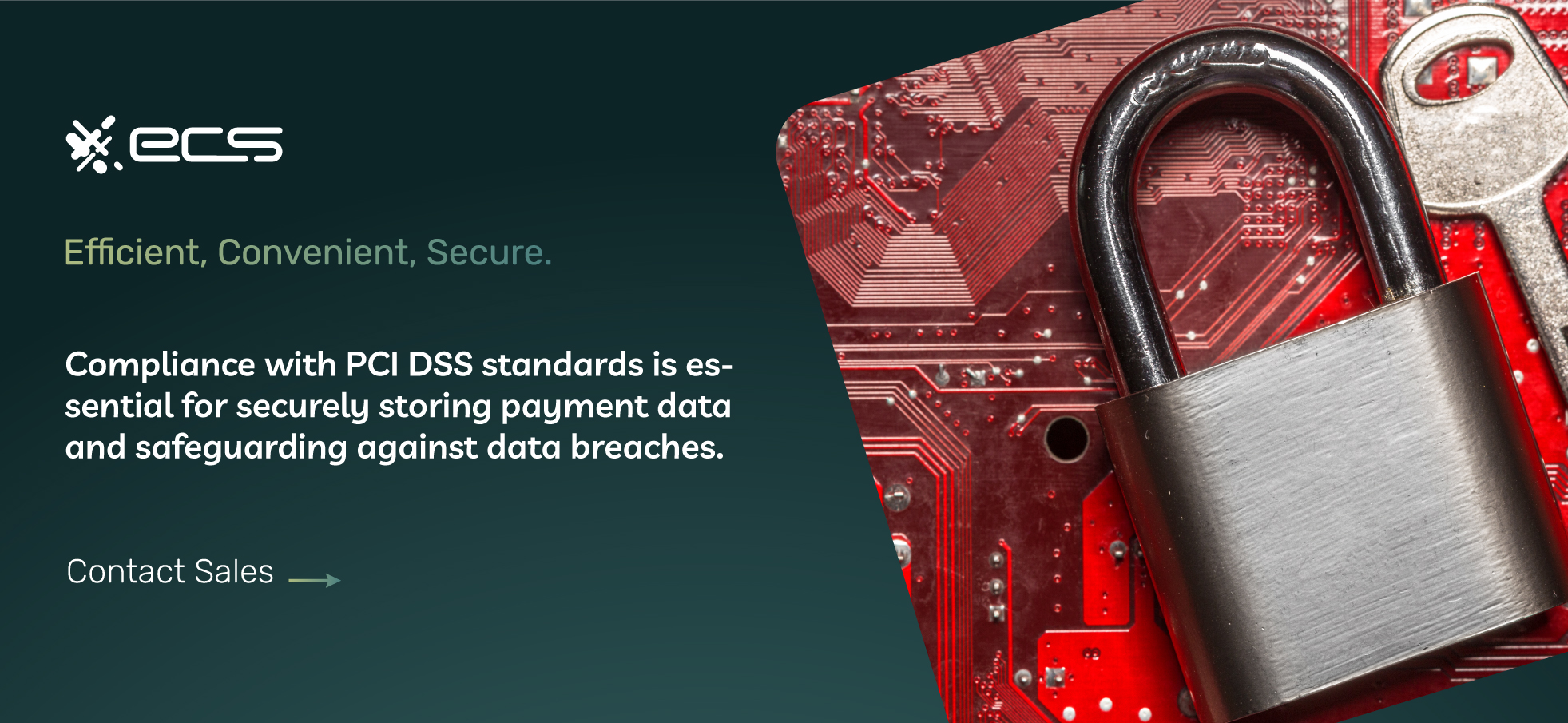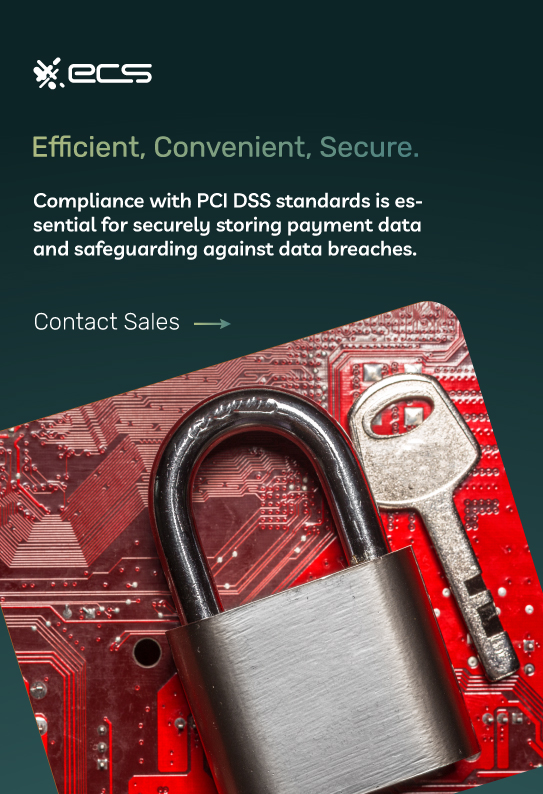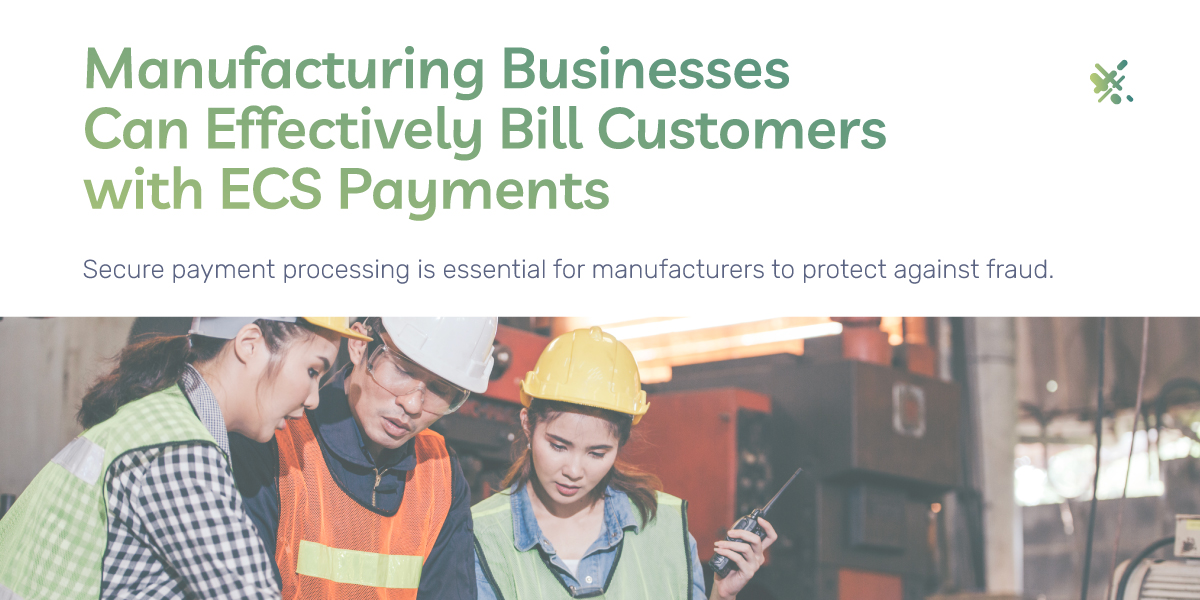Manufacturing businesses are built differently (pun intended) than retailers and even wholesalers. They have unique needs, some of which involve collecting payments from their own customers. One of these needs is sending flexible invoices to bill customers since retailing businesses often require different types of payment arrangements. Security, analytics, and mobile payment gateways are other needs and trends that shape the landscape of payment processing for manufacturers.
What Does America Manufacture?
Chemicals comprise the largest sub-sector of manufacturing, generating $350 billion annually. This is followed by two sub-sectors that are neck-in-neck, each producing about $280 billion: (1) computers & electronics and (2) food, beverage, and tobacco.
Following that, motor vehicles, metal products, machinery, and aerospace all produce about $150 billion annually. Rounding out the top ten are petroleum, coal, plastic, and rubber, each producing around $100 billion.
As you can see, a wide variety of materials are manufactured across the 580,000 manufacturing plants across America. Manufacturing comprises around 11% of the GDP. However, even if you live under a rock, you probably know that China has eclipsed the United States in manufacturing.
China now accounts for 28% of the world’s manufacturing, producing $2 trillion in goods. The U.S. accounts for about 16%, producing $1.86 trillion. And if you’re curious, the other countries holding sizable shares of the global GDP are Japan (7.5%), Germany (5.8%), and India (3.3%)

Challenges Facing American Manufacturers
These stats highlight the main challenge faced by American manufacturers: foreign competition…particularly from China. The two economies are inextricably linked, but there is a clear pattern of increasing Chinese imports.
While 8.6% of U.S. exports are sent to China, more than twice that number (17.9%) represents the percentage of Chinese imports among all products imported into the United States. We are taking in more than we put out, which is a worrisome trend for some industry pundits.
It has been argued that China’s lax treatment of intellectual property rights facilitates a grand-scale theft of American ingenuity. China benefits from a substantial, youthful workforce and leverages economies of scale to maintain low costs, providing it with a competitive pricing advantage.
Take Your Manufacturing Abroad…With Online Payments
This brings us to our first point. Your payment processor can help you increase the size of your customer base by accepting credit card payments online. Why not follow in the footsteps of America’s main competitor (China) and expand your products into new markets?
These markets could be domestic or international. An online payment gateway can allow potential customers to interact with your business anywhere in the world and place an order, and you can bill customers on a recurring basis.
You may need to pair the online gateway with some inbound marketing, such as online advertising and content creation. However, the possibility of processing payments internationally can open some doors you wouldn’t expect. The keystone holding up this customer journey is the online payment gateway.
Bringing The Customers To You With Content Marketing
Did you know that 85% of manufacturers use content marketing to generate inbound leads? Of the 15% who currently don’t, 53% plan to do so within 12 months. Did you know that 67% of manufacturers believe that NOT devoting time and resources to content marketing contributed to stagnation?
Content marketing involves creating blog articles, email campaigns, and social media posts. The idea is that potential customers will interact with some content about your industry, recognize your expertise, and then become paying customers.
Content marketing may fit into a broader picture of a sales funnel. For instance, a customer may search Google for a question about a product they need. You happen to make this product, and you’ve written a long-form article about it. The customer reads the article and then checks out your social media account, where they can watch videos of the product being made.
Bill Customers With Website Integrated Payment Solutions
Said customer is hooked. Or, if they aren’t hooked, you can use social media ads to send them some retargeted advertising. That means they and other browsers who have engaged with your posts will be shown ads for your business. Eventually, the customer will head to your website and purchase a sample.
If that all works out, it’s time to bill customers by taking a one-time payment or enrolling them in a recurring billing plan. Your online payment gateway can collect payment information like card numbers or bank account information. The payment data will be securely stored, so you don’t have to worry about it.
A customer relationship has been built without picking up the phone in an area that might be thousands of miles away. If you have the resources, you can even engage in multilingual content marketing, potentially bringing your business into foreign markets.
Integrated Payment Processing With Inventory Management
Today’s business services are all cloud-based software. That means they can be accessed remotely from anywhere in the world. It also means that the services can be easily integrated. Integration means data input to one software changes related data in another system.
Here’s an example: when a customer makes a purchase at the online “point of sale,” that information is sent to your inventory management and accounting software. It’s possible to link up your entire network of acronyms: IMS, WMS, ERP, and whatever else you are using to manage business processes.
Most analysts agree that human error attributable to manual data entry (for instance, between systems) has an error rate of around 1%. This means out of every 1,000 orders, 10 will be incorrect. Manual transfer of data is also time-consuming. It requires more staffing, more hours, and more payment to facilitate.
Integrations can save time and money while reducing errors. A payment processing company can facilitate these integrations, which require some coding on the back end. You won’t have to jump between your payment gateway, accounting system, inventory software, and dispatching software.


Securely Bill Customers
Ideally, most of your customers will be repeat customers. Their customers are individual end consumers who may only shop there once. But you are the supplier making the steady stream of goods to purvey. Your customers need a consistent supply from you, which means consistent cash flow from them.
However, that also might mean storing payment data for recurring invoices. In addition to the payment method, you’ll also need to store customer information like their business name and location. This information must be stored securely, and there are rules around what that means.
These rules are called PCI DSS or Payment Card Industry Data Security Standards. Card networks like Visa, Mastercard, Amex, and Discover create the PCI DSS rules. Many banks require companies taking card payments to complete annual PCI DSS audits to ensure they adhere to these standards.
PCI DSS Rules For Billing Customers
There are 12 main “categories” of PCI DSS rules. You must (1) install and maintain network security controls, or NCSs as they are called, such as firewalls and even physical measures such as locking up site routers. You must (2) apply secure configurations to all system components. This means changing default passwords, configuring firewalls properly, and disabling or removing all unnecessary software or systems.
You must also (3) protect stored account data with encryption and truncation, along with not sending it over insecure channels such as text and email, and (4) encrypt data while it’s being transmitted (e.g., while a customer is making a payment).
PCI DSS also requires you to (5) protect your systems and network with anti-malware software against Trojan horses, spyware, ransomware, and viruses. You must (6) apply “patches” to outdated or ineffective parts of your security measures, (7) restrict access to cardholder information only to those who need to know, and (8) provide unique ID and authentication credentials to each individual accessing card data.
You must (9) restrict physical access to cardholder data, which may even mean limiting access to payment terminals or systems, (10) actively monitor all system activity, (11) proactively test system and network security regularly, and (12) create a security policy around all these points as mentioned above.
The Easy Way To Implement PCI DSS
As you can see, this is a tall order to fill. Many components require year-round, 24/7 IT support. Unless you are a very educated octopus who excels at multitasking, you cannot handle all these considerations yourself. That means having your own IT team or outsourcing IT services to a third-party contractor.
Both options will cost money. Moreover, the cost of a PCI DSS audit alone (an annual requirement) can be outside the budget of small to midsize businesses. For large manufacturers like Exxon, Dupont, Tyson, and General Motors, that’s no problem. These companies have internal IT teams that can handle the work and corporate budgets to match.
Independent manufacturers may not have this luxury. But thankfully, there is an easier way…and it doesn’t involve growing eight arms or getting certified in IT security. You can outsource most of your PCI DSS compliance concerns to your payment processor.
Encryption And Truncation
The payment processing company that helps you take credit cards has other customers as well. The “economy of scale” is in place to make an investment in PCI DSS worth it (since they’ll need to provide it to their many customers).
We say “most” aspects of PCI DSS because you will still need to enforce some. The payment processor can encrypt and truncate payment data. Encryption (in broad terms) means securing payment information by garbling data into meaningless code that can only be decoded with a key.
The only ones who possess the key are the fintech institutions involved in running the transaction (like the banks and card networks), meaning outsiders cannot use the encrypted data.
Truncation means storing the visible form of card information in a redacted format, such as the last four numbers of the card number. There is really no reason to store such sensitive data any other way. For instance, if a customer calls about making a payment, your employee can ask if they want to use the “card on file” ending in such-and-such a number. There is no reason for the employee to see the entire card number.
What You Still Need To Do
As you’ve seen from the list above, some aspects of PCI DSS involve physical security measures. For example, you cannot take a phone call from a customer, jot down their credit card number, and then text an employee in the warehouse to run that card number (as one example).
As mentioned, each employee with access to payment systems needs a unique login. For starters, this limits the possibility of a password breach to outside parties. If the employee leaves, their login can be eliminated, and they won’t have access anymore. And if there is a breach, it is easier to pinpoint who was “at the helm” when it happened.
You cannot use the default passwords that come with hardware like routers. You also need to keep the systems locked. This means routers should be in a secured cabinet or room and not on the warehouse floor. Software should also be locked when not in use.

The Cost Of Avoiding PCI DSS Compliance
PCI DSS fines may range from $5,000 to $100,000 or more per month per offense. However, there are greater costs associated with avoiding PCI compliance, which is meant to protect you, the manufacturer, from data theft.
Most data breaches are caused by negligent employees or committed by malignant employees. A Stanford study found that 88% of breaches are caused by human error. Point #12 of PCI DSS states you must have a policy about securely storing information and fending off cyber attacks. Did you create protocols for employees about opening suspicious emails about long-lost relatives who also happen to be Nigerian royalty?
On the other end of the spectrum, there is willful data theft. As many as 75% of data breaches are caused by angry, disgruntled former or current employees. If everyone has the same password, routers are out in the open, and you don’t have firewalls in place, it’s easy for an angry employee or former employee to steal card information and use it.
Payment Processing Companies Can Provide Robust Security Features
As seen, you will need to do your part to avoid data breaches. However, a payment processing company can provide all the security tools needed on the backend. For instance, they will encrypt and truncate card data so that disgruntled employees cannot use it and hackers cannot read it.
The future of payment security probably lies in biometrics. You may already be aware of this from your own forays into inventory protection. Just like the doors to the warehouse may require a retinal scan on thumbprint, so too will access to the remotely hosted checkout pages that employees use to run phone orders.
Speak to your payment processor about the security measures they have in place to store customer payment information. It’s very convenient to store payment information so that sales with current customers can go smoothly into the checkout process. However, information must be stored correctly.
Bill Customers with Customizable Features
Another feature of robust payment processing is customizable billing options with flexible and automated invoicing. You should be able to input data that can quickly be reused for itemizing sales instead of creating each invoice from scratch.
There should also be flexible payment arrangements for your invoices. Your customers undoubtedly expect Net-30, 60, or even 90 arrangements. And what if you’d like to offer complex options like 2-10 Net 30 (e.g., 2% discount if paid within ten days)?
It is tough to juggle who has paid and who has not when you offer this type of flexibility. You can try to do it with a spreadsheet, but even without the potential human error, you will still have to follow up and call these customers.
Payment processing software can allow you to offer these flexible payment arrangements. It can also facilitate texted and emailed reminders, collect email payments (e.g., the invoice has a pay-now button), and even enroll customers in auto pay.
Advanced Reporting And Analytics
Analytics is the study of data. Your primary source of sales data will be your payment gateway. You will see exactly what customers order, how much, when, and what they order it with. You will also see where these customers are and the timing of their orders.
Imagine what you could do with such data. First, let’s look at the sales angle. If you suddenly see an influx of customers in the Southeast, there may be a trend you can capitalize on.
You could speak to some of your customers and get a sense of what’s going on. Maybe the sales team can start focusing on this region, or your paid online marketing can look in this direction.
Imagine what such data could do on the backend for your supply chain. You would be able to know when orders are coming in and what those orders will be (based on past data). You would also be able to ensure that you have the most efficient and cost-effective plan for ordering raw materials from your own suppliers.
Big data can even impact how you arrange the warehouse. Amazon uses such data points to figure out the most cost-effective arrangements for items, giving their warehouse employees just a few more seconds to grab that water bottle (actual bathroom breaks may still be under discussion after the lawsuit).

Payments Are The Key To Big Data
In 2017, the big data market for manufacturing alone was already worth $3.7 billion. However, pundits estimate it will grow at a CAGR of 20% or $10.6 billion through 2027. Manufacturers everywhere use big data to make better decisions and refine their supply chains.
Just like PCI DSS, big data was formerly the domain of corporate manufacturers only. However, the boom of cloud-based software and integrations has made big data accessible to smaller outfits. If you are a small or midsize manufacturer, you can now use the power of big data to make better decisions. The key to this data is your payment processor.
Speak to your payment processor and discover how to integrate your payments and inventory software to create an insightful dashboard. Your sales efforts, resource management, and supply chain will all benefit from analyzing your sales.
Remote Sales Teams And Paper Invoices To Bill Customers
Do you have remote sales teams? The use of such teams varies from industry to industry. While it’s not so useful in some subsectors, it is in others. Food manufacturers, for instance, do benefit from field sales, where reps actually go into restaurants.
A payment processing company can also smooth over these in-person sales processes as well. Reps can carry mobile payment gateways with them. These gateways can connect to a smartphone, or the rep can access a payment gateway online.
No more fumbling at the end of the deal to collect a credit card and call the warehouse. No more sending an invoice and having the customer cancel after thinking about it. Let’s close this deal right here, right now! This sales strategy can significantly improve the close ratio of your conversations, and it’s all facilitated by mobile payment technology.
Still want to send your customers paper invoices? No problem. Attach a QR code to the top. This lets the customer scan the code and be taken to a payment gateway right on their phone.
You can also offer options like paying online, paying over the phone, or even text-to-pay. Your payment processing company can facilitate all of these payment possibilities.
Payment Processing for Manufacturers: A Wrap-Up
We’ve covered a lot of different ways in which a robust payment processing solution can improve your manufacturing business in the accounts receivable department. To learn more, let’s continue the conversation. We’d love to hear about your business and your industry. Contact ECS Payments via the contact form on our website.
Frequently Asked Questions About How Manufacturers Bill Customers
Manufacturing businesses can effectively bill customers using ECS Payments and leverage our flexible invoicing options tailored to different payment arrangements. ECS ensures security, analytics, and mobile payment gateway options to streamline the payment process for customers.
The main challenge facing American manufacturers in billing customers is foreign competition, particularly from countries like China. This competition requires innovative approaches to expand customer bases and create easier sale processes, such as accepting credit card payments online to tap into new markets.
The majority of manufacturers use content marketing to generate inbound leads and establish expertise within the industry. By creating blog articles, email campaigns, and social media posts, potential customers can interact with valuable content, which could ultimately lead to conversion.
Payment processing companies like ECS Payments provide robust security features to ensure secure billing practices. We encrypt and truncate payment data, offer advanced reporting and analytics, manage PCI DSS compliance standards, and provide flexible payment arrangements and automated invoicing. Ultimately, these solutions enhance customer service and your business flow.
